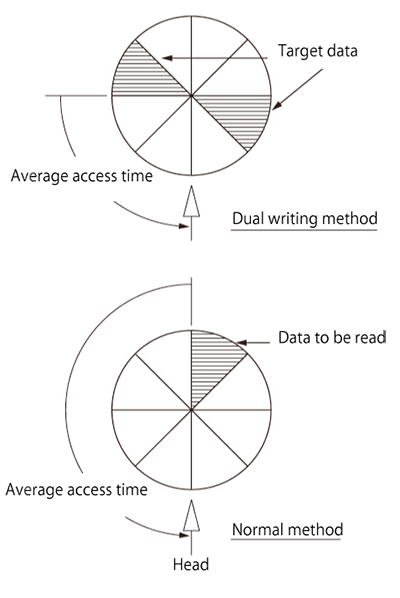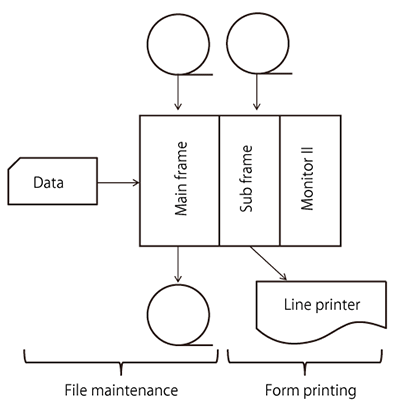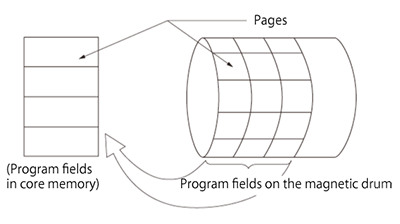SPIRAL was the general name for the basic software programs for the FACOM 230-15 and was announced together with the FACOM 230-15 in April 1970. As the replacement to Fujitsu’s best seller, the FACOM 230-10, the 230-15 was essentially a small general-purpose computer, although it was used in applications that would later become known as the office-computer category. For that reason, SPIRAL had all the functions of a small general-purpose computer operating system together with extra functions, such as kana-enabled COBOL, suited for office-computer applications that aimed to be user friendly. This article provides an overview of FACOM 230-15 SPIRAL as well as the earlier basic software for the FACOM 230-10, which was announced in March 1965.
1. Overview of FACOM 230-15 SPIRAL
SPIRAL, at its core, consisted of a group of software programs for running monitor functions, a paging function, language processing functions, and a communication function. SPIRAL consolidated these functions in order to address the requirements demanded of a small machine at the time — such as a paging function that could handle larger programs, multi-job functions for more convenient operation, and the ability to handle remote processes easily.
- (1)Monitor functions
- As a result of pursuing a control program suited to a small general-purpose computer, Fujitsu supplied SPIRAL with two monitor functions: Monitor I for single-job control and Monitor II for multi-job control. Either monitor function was capable of batch processes, inquiry processes, and small online processes. Monitor II, however, possessed two frames — main and sub — and, thereby, could run two processes simultaneously (Figure 1).
 Figure 3: Accelerating reads with magnetic drum dual writing
Figure 3: Accelerating reads with magnetic drum dual writing- (3)Language process functions
- In terms of programming languages, SPIRAL was supplied with COBOL and FOCUS for business processes and FORTRAN for scientific and engineering calculations. SPIRAL’s COBOL language was compliant with the 1969 version of CODASYL COBOL with additional commands for generating reports (control of form pages, tabulation, etc.). The report generation functions were well received by FACOM 230-15 users. FOCUS was a programming language for creating business calculation programs using six types of control cards (which could also be entered from a paper tape unit). FOCUS’s concept, however, was not so much programming as it was marking symbols on preset forms. SPIRAL also came with SL-15, an assembly language with a compiler-like notational format.
- (4)Communication function
- SPIRAL had a utility function called Corporate, which simplified the use of communication lines.
2. Basic software for the FACOM 230-10
The FACOM 230-10 was not supplied with an independent operating-system-like software program. Its basic software consisted of language processing programs — such as kana-enabled COBOL, Atom — a piece of software that ran sorts, merges, and code conversions, and software for controlling parallel operation of I/O devices. Operating-system-like functions, such as I/O functions, were supplied within each processing program. For example, the basic software routines for I/O processes and real-time processes were embedded in each language processing program. Even the software code to support random access of magnetic drum files was contained in every I/O process.
The motto for the FACOM 230-10 was “the computer that doesn’t need a computer expert.” The small computer was developed for ease of use and to promote the widespread use of computers. Both Atom and the kana-enabled COBOL language were developed with this concept in mind.
Fujitsu’s kana-enabled COBOL language was a localized version of COBOL, a global programming language, for Japanese users. It had the following features.
- Kana characters could be included in item names
- Functions were added for real-time processes
- Random processing of magnetic drum files was made possible




